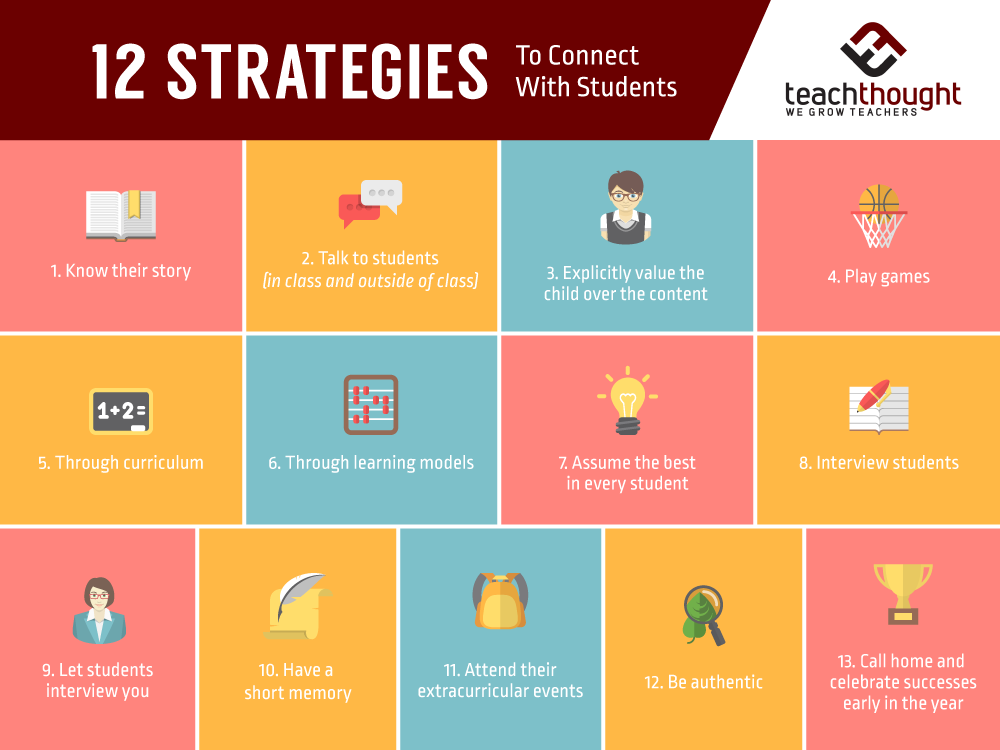
Build Better Relationships With Students Using These Strategies
Student engagement is one of the most fundamental requirements of learning. Without an engaged mind, everything else–no matter the quality of the pedagogy or the cleverness of the technology–is futile.
And one of the useful ways to make improvements here is by having a strong relationship with your students. A well-organized classroom with engaged students who trust and feel valued by the teacher is a classroom that’s set up for progress everywhere else.
So how can you build better relationships with students? Here are 12 ways that might help.
See also 10 Of Our Most Popular Articles About Student Engagement
How Can You Build Better Relationships With Students?
1. Know their story
If you don’t know ‘who’ they are and ‘where’ they come from, any relationship is entirely academic.
2. Talk to students (in class and outside of class)
How do you learn their story? Unless they have a biography you can read, talking to them–and really listening–is the best way.
3. Explicitly value the child over the content
Of course, any strong teacher already does this. But to do so explicitly is to make sure the student knows this to be true.
4. Play games
Team-building games for critical thinking, for example. Games are fun and having fun together released dopamine improves learning outcomes. Games aren’t anywhere close to the only source of dopamine–or even the best. But the bonding and ‘socialization’ that occurs is a kind of foundation for relationship-building with students.
5. Set them up for success
Creating activities or lessons that let every child shine would be great but, of course, isn’t always sustainable/practical. What is accessible, however, is to intentionally create these kinds of opportunities throughout the year. Some students love to draw while others are social butterflies. Some love to speak publically while others thrive working behind the scenes on critical projects.
Students don’t always have to be in these preferred ‘sweet spots,’ but they should have ongoing opportunities to show their talents and genius.
6. Assume the best in every student
If you do so, it will change the way you perceive certain events–behaviors, the quality of work in certain assignments, questions, etc. Sometimes you’ll be ‘wrong’ by ‘assuming the best’ in what a student meant or hoped to do and create, but by starting from this point, you give students a chance to ‘fail forward’ and learn through their mistakes and learn to self-manage.
7. Interview the student
Not like a job but not merely an informal conversation, either. Have a set of questions you create beforehand to get a fuller picture of who they are and what they need from you.
8. Let students interview you
And let them do the same to you. If nothing else, what they choose to ask will help you understand them better.
9. Have a short memory
In large part, being a child is about learning what works is what doesn’t. This requires mistakes. Lots of them. Provide clear and effective learning feedback when they fail or fall short, then move on.
10. Attend their extracurricular events
This is part of seeing them as people and not students. It will also have the effect of them seeing you differently, as well.
11. Perform (positive) home visits
Home visits can be an effective way of ‘knowing their story.’ Obviously, these need to be done as part of a concerted effort with your school or district. You can read more about home visits here.
12. Call home and celebrate successes early in the year
First impressions are so extraordinary because, in these early moments, the brain ‘learns’ someone or thing and then continues to look for data that reinforces that story. Daniel Kahneman’s ‘Thinking Fast and Slow‘ provides a compelling look at this and other tendencies of the human mind (affiliate link).
12 Strategies To Connect With Students In And Out Of The Classroom